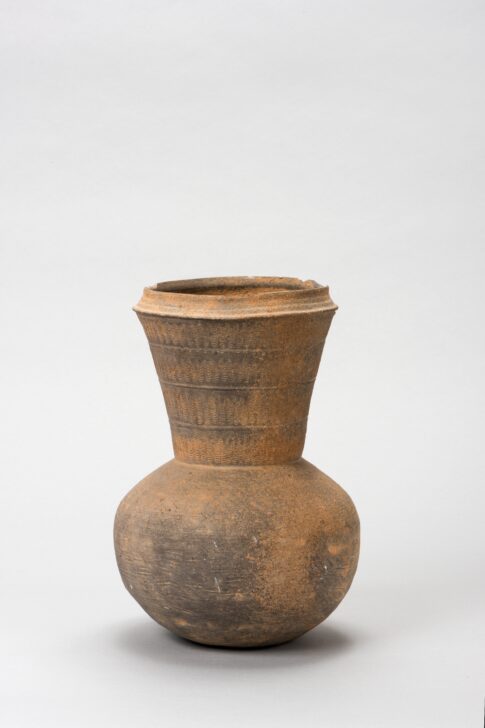Storage jar with bands of incised wavy patterns at neck; lid missing
Korean

Description
Subject Matter:
Two types of stoneware jars were made in Silla. Short-necked jars were used to store grain or liquid, while long-necked jars, often with a pierced stand, were used for ceremonies and placed in the tomb with the dead. Burial chamber were filled with such pieces, which were meant to serve the dead in the afterlife. A great deal of our understanding about the material culture of Silla comes from such burial goods. Archaeological evidence indicates that this ceramic type was first developed in the Kaya region, and subsequently adopted in Silla. They were fired at high temperature (about 800°C), in efficient, large single-chambered kilns, which made them tough and non-porous. During the firing process, ash from the burning wood would sometimes melt onto the clay body, forming a natural glaze. Korean potters soon took advantage of this and would regularly shake the firewood to encourage the ash to disperse and fall onto the body of the pot. Many long-necked jars show traces of this natural glaze.
Physical Description:
This bright grayish-blue stoneware jar consists of a round base, globular body and long flaring neck. Narrow single ridges encircle the middle part of the neck, dividing it into four sections. Each section is engraved with a wave pattern. The shoulder doesn’t have any pattern.
This is a blue-gray, long-necked, high-fired stoneware jar. The horizontal ridge on the upper part of the long vessel neck marks the boundary between the neck and its inwardly curved mouth. The mouth slopes inward and has a sharp edge. The neck is divided into four sections by three horizontal ridges spaced at equal intervals, and each section is decorated by a wave design rendered with a comb with approximately ten teeth. The jar is widest at its upper-middle part, and the base is round with a slightly recessed center.
[Korean Collection, University of Michigan Museum of Art (2017) p. 47]
Usage Rights:
If you are interested in using an image for a publication, please visit https://umma.umich.edu/request-image/ for more information and to fill out the online Image Rights and Reproductions Request Form.